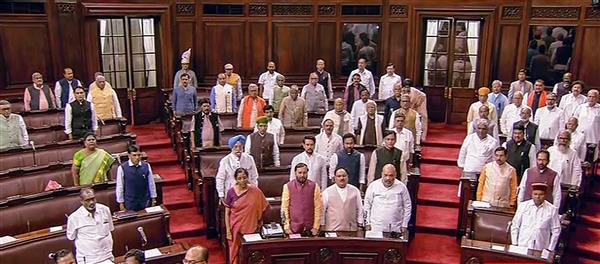The Central government has announced an economic package which is supposedly about 10 percent of India’s gross domestic product (GDP). GDP is a measure of the economic size of a country. India’s GDP is around Rs 200 lakh crore. That’s how the 10 percent of that works out to Rs 20 lakh crore, which is the size of the government’s economic package.
Sections of the media are also calling it an economic/fiscal stimulus though the government has avoided using this term in its published communications. They have stuck to the term economic package.

File image of Union finance minister Nirmala Sitharaman. ( Photo courtesy: social Media)
But more than anything the Rs 20 lakh crore number being bandied around is basically a hodgepodge adding up of a different set of numbers, which shouldn’t be added up in the first place. Let’s try and understand why, in a pointwise way.
1• Let’s start in a simple way. For the next three months, the statutory provident fund contribution made by both the employee and the employer will be reduced to 10 percent of the salary (basic salary + dearness allowance) from the mandated 12 percent. The government expects this move will add liquidity support of Rs 6,750 crore.
It is important to understand that the government is not spending a single rupee of its own here. A cut in provident fund contribution will increase the monthly take-home pay of the salaried class for the next three months. Of course, with investment towards tax savings going down (investment in the provident fund counts for that), the income tax payable will go up (for those who come under the tax bracket).
But at the end of the day, it is people’s money being paid out to them instead of being invested in a provident fund. Other than possibly paying tax on this extra income, people are also losing out on the interest they would have otherwise earned over the years.
Yes, this move might help the economy, with more money in their hands people might spend more. But how can this be counted as a part of an economic package of the government? Even if they spend this money, people are spending their own money at the end of the day.
2• The government has also announced that all pending refunds to charitable trusts and noncorporate businesses and professions including proprietorship, partnership, LLP and Co-operatives shall be issued immediately. Again, this is money owed to different firms and institutions by the government and is being returned to them. How can this be a part of any economic package?
3• Let’s look at another such move. The rates of tax deducted at source/tax collected at source have been deducted. These are basically ways through which the government collects a part of the tax in advance and establishes some sort of an audit trail. This does not mean that overall tax rates have been lowered. Up until now, a tax deducted at source of 10 percent had to be paid if the interest earned on fixed deposits in a bank crossed Rs 10,000 during the course of any year.
This has been lowered to 7.5 percent. Earlier, in case of individual earned an interest of Rs 1 lakh during the course of any year, the tax deducted at source by the bank would have been Rs 10,000 for that year. Now it will be Rs 7,500.
Having said that income tax on the Rs 1 lakh earned continues to remain the same and will have to be paid before the due date. This move, of course, helps people and businesses with cash flows. This is expected to add Rs 50,000 crore to the liquidity as per the government. Again, the government isn’t allocating any of its money towards this. It’s just that a part of the tax payment is getting postponed for a few months.
Of course, that helps, by putting more money in the hands of businesses and people, even though briefly. But how can this so-called liquidity support of Rs 50,000 crore (again people’s money, a large part of which will go to the government eventually) be a part of an economic package?
4• The biggest announcement made as a part of this package has been the Rs 3 lakh crore collateral-free loans for small businesses with a turnover of up to Rs 100 crore and loans of up to Rs 25 crore, to be giving by banks and non-banking finance companies (NBFCs). The government has given a credit guarantee of 100 percent on these loans (both principal and interest). What that means is that in case of a default, the bank or the NBFC facing the default can cash-in the guarantee from the central government and get paid instead of incurring losses.
Again, a good move to get the credit in the economy going at this point of time, when banks and NBFCs are reluctant to lend.
But the question is what is the government spending on this immediately? Nothing. It has built up what is called a contingent liability and it will have to allocate money towards it in the years to come. These loans will have a tenure of four years with a moratorium of 12 months on the repayment of principal. The money that the government allocates towards the possibility of these loans being defaulted on, the banks cashing on the guarantee and the government having to pay up, will be spread across a period of four years.
Hence, the government is leaning in on the banking system to get credit going again. A good move, but the government isn’t paying anything out of its own pockets immediately.
5• Along similar lines, the government is guaranteeing the borrowing of NBFCs, housing finance companies and microfinance institutions with a low credit rating, up to the extent of the first 20 percent loss.
The government expects this move to lead to these financial institutions being able to borrow up to Rs 45,000 crore if other financial institutions are willing to lend (given that the guarantee is only up to the first 20 percent of the loss). Again, the government is not spending any of its own money on this move immediately.
6• The Power Finance Corporation (PFC) and the REC Ltd will infuse Rs 90,000 crore into power distribution companies, which are currently struggling. This money will be a loan given against the receivables or the money that is owed to the power distribution companies. This money will have to be used by power distribution companies to pay what they owe to power generating companies. The loans will have to be guaranteed by the respective state governments.
This is a problem that is has been festering for a while now. The current economic scenario has only accentuated it. The government trying to solve it is a good thing. Nevertheless, the Central government isn’t really putting any of its own money into this.
To cut a long story short, whatever has been announced by the government as a so-called economic package, isn’t really much of a package. It is basically a combination of putting people’s own money into their hands and encouraging the financial system to give out more loans. This doesn’t amount to a fiscal/economic stimulus as the media is calling it. In any economic/fiscal stimulus, the government should be seen putting its money into the hands of people. That is clearly not the case here.
The writer is the author of the Easy Money trilogy.







































